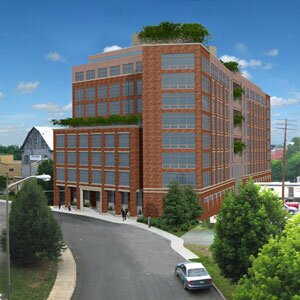When Time Magazine decided to focus on the green architecture movement in 2001, reporters sought out Randy Croxton. His National Resources Defense Council building in New York City is considered a seminal project in the green architecture movement, one of the first American projects to embrace the ecology of a building. Since then, his Croxton Collaborative Architects have become world-renowned experts on green building, even designing (along with locally based William McDonough) Wal-Mart's first environmentally friendly store in Lawrence, Kansas.
However, when Croxton came to Charlottesville in December for his "BAR moment"-- in local architect Bill Atwood's phrase-- planners seemed decidedly unimpressed.
At a December 19 meeting, the Board of Architectural Review approved by the slimmest margin Croxton's design for a 9-story luxury green condominium between the barn-like headquarters of Beck-Cohen heating and air-conditioning and the CSX railroad tracks along Water Street. According to Croxton's website, the building will be the first residential building in America to win "platinum" status from a group called Leadership on Energy and Environmental Design, meaning it will hit a high note on all five major keys of human and environmental health: sustainable site development, water savings, energy efficiency, materials selection, and indoor environmental quality.
Still, the BAR peppered Croxton with stipulations about the color of window frames and bricks, and suggested subtle design changes that would keep the building from looking too much like just another mondo condo. Clearly, some BAR members were unhappy with the sheer mass of the building, which rises steeply beside the Belmont Bridge. In the end, a single vote kept the project alive: the BAR voted 4-3 to approve.
"It's a difficult design problem for us," says BAR vice-chair Syd Knight, who voted against the project. "It's the first truly large building for that area, and some of us felt it would dwarf everything around it." Knight was concerned the building was too large to have any meaningful contextual relationship with the neighborhood, particularly the historic Beck-Cohen building, formerly a flour mill, which he thinks 201 Avon could "potentially overshadow." Knight concedes that that part of town could be destined for more vertical growth, but wants to see it happen slowly, carefully.
And what if this gigantic building gets built and nothing else nearby follows? "That prospect gave us all pause," he says.
BAR member Lynne Heetderks, who also voted no, worried that 201 Avon would "overwhelm" the old mill. Although she expressed some willingness to be persuaded about the mass of the building, in the end she felt the project showed a "lack of respect" for its historic neighbor.
And although Brian Hogg and BAR chair Fred Wolf voted for approval, Wolf said he was feeling only "fairly comfortable" with the project, while Hogg, who said he was comfortable with the size, mentioned he was "unhappy" with the design, which he called "extremely busy." Not exactly a rousing endorsement for the famous Mr. Croxton.
In principle, Knight thinks City planners are comfortable with the way development is evolving around the perimeter of the Mall-- the area where most of the tall building projects in the pipeline are slated to arise-- but says that architects and developers need to understand the City's desire to protect the integrity of neighborhoods.
Of course, outside the more idealistic issues of planning and design lurk a number of other concerns. As city planner Brian Haluska points out, BAR approval is only one of many hoops the project must jump through. Besides securing city approval for the site plan-- a decision expected in November, and which includes studies on traffic, parking, and utilities-- developers typically need to have 30 percent of their condos sold before a bank will approve a construction loan. As a consequence, there's the possibility that developers might decide the project isn't worth it. According to Haluska, builders have three years after a permit is issued to decide if they want to build.
Will people be willing to pay $200-$350 a square foot for a high-rise home on an industrial site abutting the railroad tracks and near the amphitheater? Haluska says the market's decision is not necessarily a big concern for the city, which still receives taxes from the property no matter what happens. But it's a major concern for builders. And as his prediction about when 201 Avon might get built not-so-subtly suggests, the fate of this green being is still uncertain.
"Hypothetically, 201 Avon could get built next spring," he says, "or five years from now... or never."

Too big? This mega-condo at 201 Avon Street passed BAR muster by a single vote in December.
From Croxton Collaborative Architects' website
#